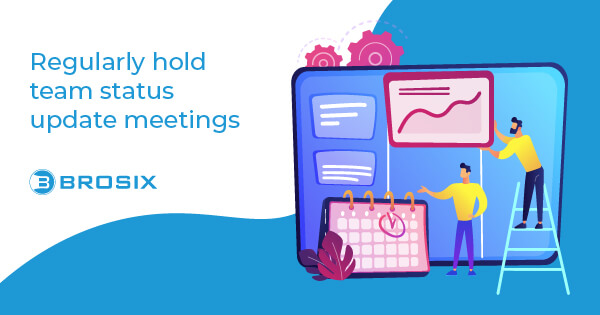Nearly every type of work requires synchronization between team members and weekly updates are a huge part of tracking progress. Team updates keep everyone informed and contribute to the project’s overall success. With hybrid and remote teams becoming more popular, holding productive meetings has become even more challenging.
By adjusting how and when you hold team meetings, you can make them meaningful, shorter, and more efficient. In this guide, we’ll share tried and tested methods and best practices that will help you achieve that. Keep reading to find out the details.
Best Practices for Effective Team Updates
If you want to re-evaluate how you manage team updates, here are 6 best practices to help you handle them with ease and transparency.
Bring in weekly updates
One of the first steps you can take is to introduce weekly status updates. In case you don’t convene a team meeting every week, you might be saying, “but wait, that’s even more meetings; it’s only going to be worse!”
Actually, it won’t. Team status updates can be a brief affair. If everyone sticks to the plan and team members each have no more than a minute or two of talking, they can be highly efficient.
Furthermore, if you organize meetings at a slower pace, the agenda for each meeting will be much more significant. As time passes, all kinds of developments will take place, and you’ll have to cram all of that into a single meeting every few weeks.
On the other hand, if you organize a meeting every day or every few days, you simply waste precious hours. Weekly team status updates are frequent enough to cover everything without sacrificing productivity or time.
Introduce standup meetings
The meeting’s environment can have a considerable impact on their dynamic. When you have to wait for everyone to get seated at a large table, fetch their coffee, and bring out their notes, you just bleed productivity.
A great solution to this is to switch to standup meetings. First, they’re much easier to organize – you can just find a meeting lobby instead of looking for an office to house the whole team. Second, team status reports will be significantly shorter with everyone standing. No one likes to stand in place for a long time, while you can get pretty comfy in those huge chairs in the meeting room.
This advice can be used in conjunction with the previous. You can turn weekly team status check-ins into standing meetings and keep them even shorter. Alternatively, you can mix in daily standup meetings with your regular, seated ones. That way, daily standup meetings can be used for brief chats between teammates, while non-standup ones are reserved for broader discussions.
By switching to standup meetings, you save on both time and logistics. It probably isn’t bad for your glutes either.
Not everything has to be a team meeting

Now is the time to quote another often-used phrase – “this could’ve been an email”. This rings true in many cases, as not all team updates or discussions have to be shared through a meeting.
First of all, there’s the email mentioned above. Team members can be asked to email their progress or attendance report, while leaders can share essential developments.
Of course, email isn’t the only solution here. Pretty much every self-respecting company now uses online collaboration or instant messaging platforms. Platforms like Microsoft Teams, Slack, or Brosix give you a lot of different channels for communication.
Brosix is packed with features that let your team share updates quickly and effectively, without convening a meeting. Brosix’s broadcast messaging tool is tailor-made precisely for this task.
With it, you can communicate new information or daily updates without interrupting any work processes. A team leader can broadcast a public message to his team through the broadcast tool notifying everyone of new developments in the current marketing campaign. That way, everyone will be notified while the message won’t get accidentally looked over or lost in the group chat.
On top of that, Brosix also supports practically all other channels of communication if you prefer sharing updates via audio or video.
Alternatively, everyone can just hop on the Brosix app, join the group chat and share their weekly update. Besides organizing a meeting chat, you can also use audio or video calls for team status chack-ins. They’re perfect for sharing all news and essential info without the hassle of planning a full-on meeting.
Regularly hold team status update meetings

Whichever form or frequency of team check-ins you decide on, make sure you stick to it. It’s all too easy to skip one or two meetings because something came up. This then turns into a habit and after a while, no one takes these team events seriously and team attendance suffers.
Employees disregarding meetings and not treating them as necessary is a real risk. They might then skimp on their reports, not pay attention, or just sleep through them.
To avoid this, keep status updates and weekly meetings regular, and make them mandatory for team members. This isn’t just for authority’s sake – if everyone takes team updates seriously, they’ll be more productive and shorter as a result.
Make sure to showcase to team members why status updates are important and how they contribute to overall productivity. By holding efficient and regular updates, you’ll cut down on other meetings and everyone will benefit.
Hold informal team events
Things like weekly lunches, collective breaks, and Friday drinks are great opportunities to feel your team’s pulse. Of course, these events shouldn’t be all about work, that defeats the point. However, since they usually happen during work time and between colleagues, they often segway into work talk.
During these gatherings, you can see what team members think and how they’re doing with their work. While unstructured, this feedback can be beneficial, as people won’t be constricted by the formality of traditional status updates.
Informal events also have the desired side-effect of making team members more relaxed and at ease. Sprinkle in just a few social events at work, and you’ll see everyone feeling better and more productive. Just remember not to make them all about the job – leave room for fun too.
Provide feedback on status updates
Lastly, team leaders should remember to provide direct and helpful feedback on status updates provided by employees. If you’re in a leadership position, make sure to go over and actively listen to what everyone says. When the leadership doesn’t give significance to a team’s meeting, why would regular employees?
After receiving constructive feedback, people will know that you’ve actually paid attention. They will feel heard and appreciated and put in extra effort to do better.
Overall, giving feedback will increase the quality of status updates and other meetings and showcase their importance. Even if there’s nothing special to be said, a short confirmation or even just “thanks for the update” can go a long way. In a virtual setting, emojis alone can do the trick.
Holding a Good Team Check-In: The Checklist
To summarize, here’s a team update checklist to consult when planning a reorganization:
- Keep them short
- Hold them weekly
- Make them regular and mandatory
- Mix them with informal events
- Introduce standup team update meetings
- Provide feedback when possible
- Don’t turn everything into a team meeting
Why Are Team Status Updates Challenging?
Let’s get into the most common challenges you might face if you don’t optimize how you hold team meetings.
They last too long
One of the biggest roadblocks team members face with updates or meetings, in general, is their length.
Humans seem to have an uncanny ability to make even the simplest, straightforward meeting into a two-hour affair. This wouldn’t be such a problem if this time were spent wisely. However, these large meetings often end up re-enacting one of two scenarios. In the first scenario, the team updates meeting consists of people simply sharing their status and progress. Here, only one person is actively talking, whereas others passively wait their turn and go back to sleep.
In the second scenario, team members quickly derail the meeting’s agenda. What was supposed to be a meeting addressing three bullet points, turns into a lengthy discussion and all semblance of order is lost.
Either way, valuable time is wasted and attendees often switch off and become bored after a while. To avoid these common pitfalls a better organization is needed.
They affect productivity
Both team leaders and members surely know how fatal a poorly timed and delivered meeting can be for productivity. This, of course, is directly related to the sheer amount of time we often spend in these meetings.
The longer you’re held up in collective video calls, weekly updates, or 1:1 briefs, the less time you have to actually do your job. This then impacts your company’s profits and growth. The term “time is money” might be overused, but it certainly applies here.
Also, the content of the meetings themselves can stifle the creative process. If you feel like you’re attending the same meeting day after day, where nothing of particular importance is said, it definitely won’t do wonders for your motivation.
They bring down team morale
The length of team member meetings and their effect on productivity can also bring down team morale. Many meeting attendees come to hate weekly updates and other gatherings because these meetings make it much harder to manage work.
If you have a project to finish, a design to wrap up, or emails to send, meetings always seem to come at the worst possible moment. You then have to drop what you’re working on, hop on the group call or walk to the meeting room and waste time better spent working.
Especially if meetings become tedious or inefficient, team members will start dreading them. These meetings will create a sense of needless stress and prompt employees to switch off during team status updates, just willing them to end.
Final Thoughts
There you have it. Hopefully, we’ve covered all the common pitfalls of organizing team updates and have learned how to avoid them.
If you want to reach milestones faster, have a high-performing team, and encourage employees to do their best work, you might need to change your current project updates dynamics. Don’t be disheartened if you don’t see improvements right away. Everything takes time, especially when switching up a core company dynamic, such as team status updates.
Another thing to keep in mind is that perhaps some of the advice we’ve given here won’t suit every company or team. A data scientist department functions very differently from the social media marketing team. Still, a lot of these team update practices are general enough to be applied in different contexts.
And if you’re searching for a communication tool to help you with the team updates – give Brosix a try!





